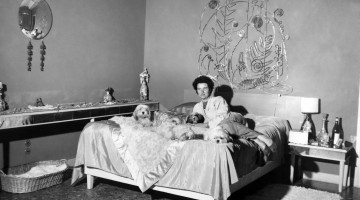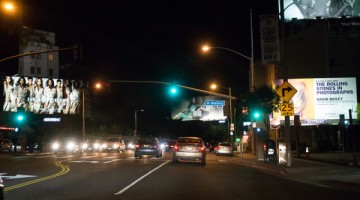
Dorothea Tanning. Notes for an Apocalypse, 1978. Oil on canvas. 50 x 62 in. Courtesy Gallery Wendi Norris.
When journalists interviewed artist, novelist, and poet Dorothea Tanning—who passed away in January of 2012—they couldn’t resist asking her about her late husband Max Ernst and her Surrealist work. Never mind that she produced a large and eclectic body of work since her first solo exhibition in 1942 until her death, she moved on from Surrealism in the 1950s, and Ernst passed in 1976. Tanning was defined by others as her romantic self and the few emotional states that correlate with idealized femininity and an obtuse interpretation of Surrealism: Freudian hysteria, absurdity, and seductive sexuality. (This is less of a problem for female artists established in the last twenty years, but these talking points are still the primary narrative for mainstream celebrities.) Tanning made a lot of paintings with nude figures. Some were erotic, but not every painting with a naked body is erotic (McCormick). Gallery Wendi Norris’ survey of work made in 1960’s and ‘70s in France, “Unknown but Knowable States,” presents Tanning as an artist. Not so much a former Surrealist, not Max Ernst’s wife, not a woman; it’s not an overt avoidance, just that these things are minimally consequential.

Dorothea Tanning. Philosophie en plein air (Fresh-air Philosophy), 1969. Oil on canvas. 52 1/2 x 65 1/4 in. Courtesy Gallery Wendi Norris.

Dorothea Tanning. A la derive (Adrift), 1967. Oil on canvas. 78 3/4 x 51 1/4 in. Courtesy Gallery Wendi Norris.
The show’s accompanying catalog features an essay by Catriona McAra, “Kaleidoscopic Eyes: Cytherean Voyages in the Post-Surrealist Practice of Dorothea Tanning.” McAra addresses Surrealism and Ernst only when necessary. Her thesis is contingent a quotation by poet Jean Christophe–Bailly on Tanning’s work, as morphing pieces of the “layers of her consciousness,” and conjecture that she used a kaleidoscope for her compositions. It seems obvious that an essay by a woman for a gallery owned by a woman would be free of of sexist tropes, but it was surprising considering the pervasiveness of the Tanning Narrative.

Dorothea Tanning. Salut, délire! (Hail, Delirium!), 1979. Oil on canvas. 44 x 82 in. Courtesy Gallery Wendi Norris.

Dorothea Tanning. L’Heure mauve (The Mauve Hour), 1965. Oil on canvas. 7 1/8 x 5 1/2 in. Courtesy Gallery Wendi Norris.
Christophe–Bailly’s kaleidoscope isn’t just a fan dance revealing pieces of Tanning; it’s the kaleidoscopic selves within her. These are the selves that cohabitate within all of us, mostly in opposition with each other, and take control of us one or two at a time. André Breton’s 1924 definition of Surrealism as “psychic automatism” gave those selves a chance of expression through automatic writing and drawing. With a sigh, “Still in the Studio” is exhausted and emotionally isolated by work. “Notes for an Apocalypse” is the aftermath of a violent fantasy. You knowingly fall into “Salut, déliere! (Hail, Delirium),” unable to stop yourself, and settle in to vague misery. “L’Heure mauve (The Mauve Hour)” is also the magic hour, when warm light makes everything look more beautiful and you are ecstatic to be alive. Known states are the selves you choose to be (work self, family self). The “Unknown But Knowable States” are internal places and selves you can’t deliberately get to—the quality of light flips a switch inside you and you’re there.

Dorothea Tanning. Étreinte, 1969. Wool flannel and fake fur stuffed with wool. 40 x 40 1/2 x 21in. Courtesy Gallery Wendi Norris.

Dorothea Tanning. Still in the Studio, 1979. Oil on canvas. 51 3/16 x 38 3/16 in. Courtesy Gallery Wendi Norris.
While Tanning was documenting these elusive interior states, she employed a variety of techniques, often all in one painting. She rubs the paint in and off to reveal the canvas, makes seamless and bleeding lines wet into wet, layers complexly, uses murky colors, and adds a spot of vivid paint from the tube. These are some of your many selves and these are some of the many ways they can be expressed. The reductionist perspective of Tanning is especially unfair because she was preternaturally attuned to life’s complexity, and possessed the rare gift of elucidating even the most fugitive states. In her painting styles, drawings, soft sculptures, writing, and poetry, Tanning shows her well-examined abundance of self.
“Dorothea Tanning: Unknown but Knowable States” is on view at Gallery Wendi Norris through March 2, 2013.
-Kendall George
Citations:
Breton, André. First Surrealist Manifesto From Le Manifeste du Surréalisme, 1924. Patrick Waldberg, Surrealism (New York: McGraw-Hill, 1971), pp. 66-75. Web 10 January 2013. http://www.tcf.ua.edu/Classes/Jbutler/T340/F98/SurrealistManifesto.htm.
McCormick, Carlo. Interview with Dorothea Tanning, BOMB 33, Fall 1990. Web 9 January 2013. http://bombsite.com/issues/33/articles/1353.


